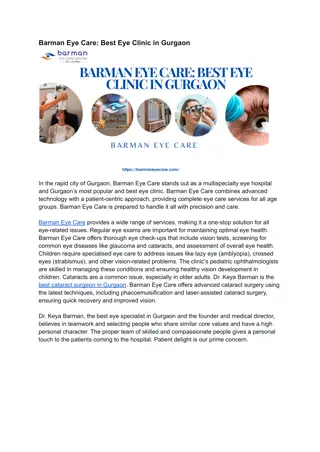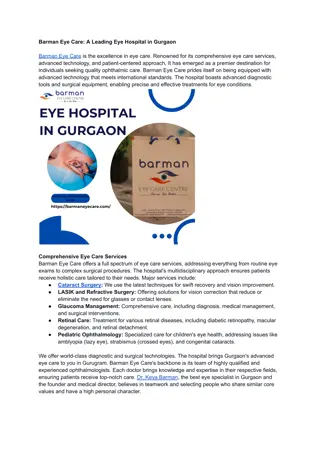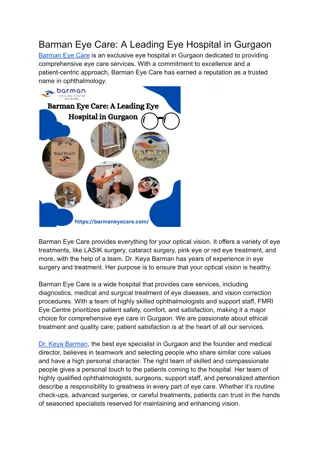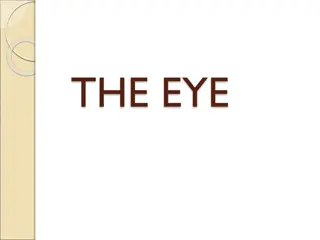Exploring the Importance of Sight and the Anatomy of the Eye
Dive into the significance of the sense of sight, why it is crucial, and how the eye functions to process visual information. Discover the roles of different eye parts, such as the cornea, iris, retina, and optic nerve. Engage in experiments to understand how light affects the eyes and learn about the protective mechanisms like eyelashes and eyebrow.
Download Presentation

Please find below an Image/Link to download the presentation.
The content on the website is provided AS IS for your information and personal use only. It may not be sold, licensed, or shared on other websites without obtaining consent from the author. Download presentation by click this link. If you encounter any issues during the download, it is possible that the publisher has removed the file from their server.
E N D
Presentation Transcript
Ear - Body Part Clip Art Sight Smell Hearing See full size image Touch Taste
Why are the senses important?
Today we are going to look at the sense of sight !!!
Why is sight so important?
Experiment Time!!!
Lets Predict: What do you think happens if a flash light is shone straight into your eyes? 1. or 2. What do you think will happen to your eyes when in a dark room?
Functions!! Eyebrow = Keeps sweat from the eye! Eyelashes= Protects the eye by keeping dust out! Eye lid= Protects the eye by blinking!
Functions!! Sclera = white part of the eye. It covers the eye and protects it! Cornea = transparent, it allows light to enter the eye. It helps the eye focus as light makes its way in. The cornea helps to bend light into our eyes.
Functions!! Behind the cornea: Lens=The lens is the transparent part in front of our eyes. It helps to bend light onto the retina. Iris = gives the eye its colour. It also controls how much light enters the eye by changing shape! Pupil= black circle in the centre of the iris. It lets light enter the eye!
Functions!! Tear- duct = cleans the eye by producing tears! Retina = recognises light! Optic nerve = sends messages from the eye to the brain!
What happens when too much light enters the eye???
When light shines into the eye, the pupils get smaller. How does this happen??
When light enters the eye, the iris makes the pupil change. The pupil becomes small to stop too much light entering the eye. See full size image
When there is not a lot of light entering the eye, the pupil enlarges! See full size image
How do we see??? When light passes through the eye s lens and the image hits the retina, the image is actually upside down. This message that the optic nerve brings to the brain is upside down too. BUT luckily, your brain knows how to flip the image over so its right- side up!
Have your eyes ever played tricks on you?!!!
The blind spot is the area on the retina without receptors that respond to light. Therefore an image that falls on this region will NOT be seen. It is in this region that the optic nerve exits the eye on its way to the brain. To find your blind spot, look your piece of paper.
Blind Spot Close your right eye. Hold the image (or place your head from the computer monitor) about 20 inches away. With your left eye, look at the +. Slowly bring the image (or move your head) closer while looking at the +. At a certain distance, the dot will disappear from sight...this is when the dot falls on the blind spot of your retina. Reverse the process. Close your left eye and look at the dot with your right eye. Move the image slowly closer to you and the + should disappear.
Depth Perception Two eyes are better than one, especially when it comes to depth perception. Depth perception is the ability to judge objects that are nearer or farther than others. To demonstrate the difference of using one vs. two eye to judge depth hold the ends a pencil, one in each hand. Hold them either vertically or horizontally facing each other at arms-length from your body. With one eye closed, try to touch the end of the pencils together. Now try with two eyes: it should be much easier. This is because each eye looks at the image from a different angle. This experiment can also be done with your fingers, but pencils make the effect a bit more dramatic.























